The COVID-19 is having an impact on several sectors of the economy, and the power sector is not spared. The electricity sector is an integral part of the economy. The importance of its monitoring lies in the fact that it can help us: (1) prepare for futures challenges in the electricity sector associated with the revenue gap in the following months; (2) track the economic activity, as GDP growth is one of the key variables impacting demand growth. The monitoring of power demand, which we can observe almost in real-time (thanks to the system operator’s information) is also a good indicator of the size of the productive sectors that are frozen (i.e. ready to operate, but with excess productive capacity).
When comparing electricity demand this year to that of 2019 in Latin America and the Caribbean (LAC), it decreased between 4% and 28% in the last week of March. The disparities between the different countries result from the different measures to contain the COVID-19 on the one hand, and on the demand characteristics of each country on the other hand. Under normal circumstances, LAC’s power demand would be expected to increase between 2.7%–3.6% annually. The observed demand decline in times of COVID-19 implies that an important part of the generation capacity will be in excess which is a significant cost for the sector. Depending on who bears the cost and how it is managed, a severe sectorial crisis might follow.
Figure 1: Electricity Demand Drop Between the Same Week in 2020 and 2019 (week of reference 30 March – 5 April)
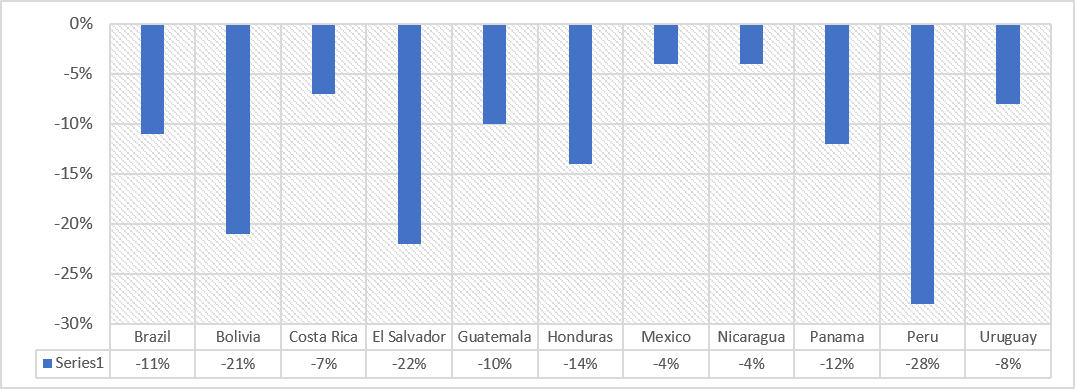
Source: Own elaboration, based on data available from system operators in LAC (2020)
The demand for electricity by sector varies considerably across LAC countries. Peru is a textbook example of how a reduction in mining activity drove the electricity demand down. Mining is the country’s main economic activity, consisting of roughly 60% of its total exports and 10% of its GDP.
By contrast, electricity demand in the residential sector is increasing. As such, countries showing higher participation of residential consumers in total demand will probably see lower reductions in the electricity demand. Nonetheless, consumers may see an increase in their electricity bill, which can be a challenge for the most vulnerable ones. Overall, in every LAC country, the impact of the crisis on productive activities (such as industrial, agriculture, fishery, mining, commercial, services) will be strongly correlated with power demand.
Figure 2: Electricity Demand by Sector (2018)
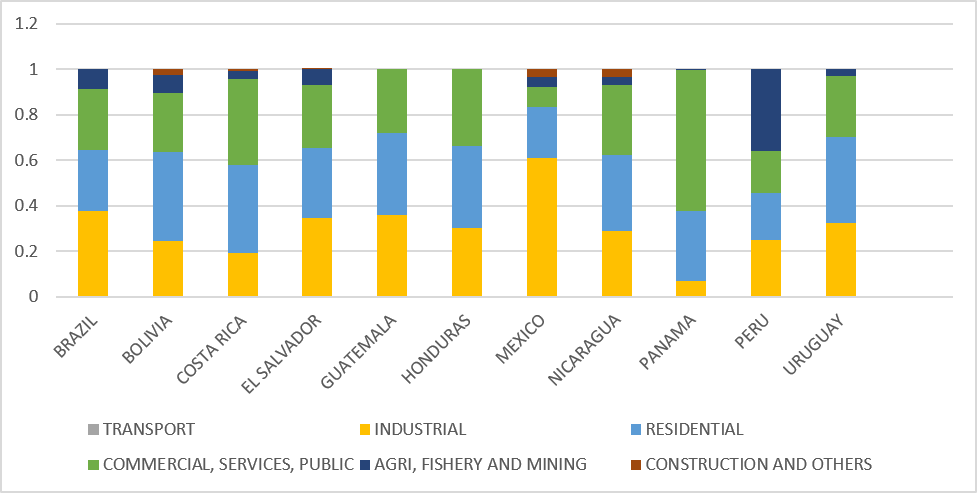
Source: Own elaboration, based on data from OLADE (2020)
The impact of the crisis is not only seen in electricity demand, but also in the characteristics of the demand profile. The latter has to do with the hours of the day during which electricity is most required. The reasons behind the changes in the demand profile are manifold. First, there is an increase in residential consumption. Second, there is a change in the hours of residential consumption. Third, there is a decrease in industrial and commercial demand (which have a different profile). Countries such as Bolivia, El Salvador and Panama show the biggest changes in their profile. These are not only driven by changes in the amount of energy, but also by who and how the profile was changed.
Figure 3: Electricity Demand Decrease by Hour (30 March – 5 April)
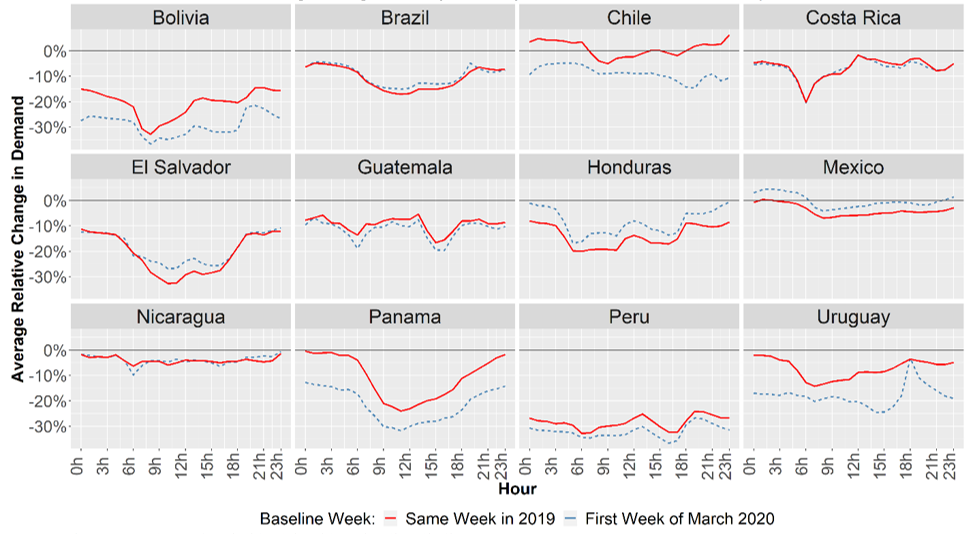
Source: Own elaboration, based on data from system operators (2020)
Figure 3 shows the hourly demand differences between the first week of April (30 March – 5 April) this year compared to the same week last year (red line), and the first week of March this year (blue line). We can see that in countries such as Costa Rica and Brazil, both curves are similar, meaning that between 2019 and 2020 (even before the crisis), the demand profile did not change substantially. In Panama, the curve has the same profile, and the difference is associated with the increase in energy demand, as expected, between 2019 and 2020. This same tendency can be seen in countries such as Peru and Guatemala. By contrast, countries such as Bolivia and Uruguay exhibit more substantial changes in their curve profiles, meaning that seasonal (and weather-related) effects may play a role in March. This is particularly relevant because of the increasing participation of residential demand (seen by some of the productive demand’s decline).
Bolivia
The first case of COVID-19 in Bolivia was confirmed on March 10. On March 15, the government announced that social gatherings above 100 people were prohibited, limiting the functioning of bars, cinemas and gyms. From March 22, it instituted a public quarantine that was extended until April 30. The markets would remain open until noon only. Industries, banks and production centers for basic goods would continue to function normally. Bolivia’s economy is based, above all, on the extraction and export of natural resources, mainly natural gas and mineral products, and to a lesser oil and food products.
The extent to which the COVID-19 has been impacting Bolivia’s economy is the direct consequence of sanitary measures on the one hand, and the indirect consequence of the unprecedented crash of oil prices and its consequent impact on natural gas on the other hand. Whereas the relation between natural gas’ prices and oil is not straightforward, especially in long-term contracts traded through international pipelines (as is the case in Bolivia), it will become stronger, as these long-term contracts have adjustment clauses based on oil-derived fuel basket that are quoted internationally. There is a delay in the adjustment often quarterly adjusted and lower volatility than international oil prices, but it is strongly impacting Bolivia’s economy.
The decline in electricity consumption has already started to manifest itself in the third week of March, with an average reduction of 12.02% compared to the first week. In the fourth week of March and the in first week of April, the drop in demand deepened further, with an average reduction of 26.69% and 28.05%, respectively, over the same period. The movement of continuous fall in demand is clear, as the sequence of weekly consumption curves show (darker colors represent more recent weeks).
Figure 4: Electricity Demand Decrease by Hour in Bolivia (24 February – 5 April)

Source: IDB using data from the CNDC (2020)
Brazil
Brazil confirmed the first case of COVID-19 in Latin America on February 26. Measures for social distancing in the country have been defined mainly at the level of the federation’s states. The most affected states, such as São Paulo, Rio de Janeiro, Ceará, Pernambuco, and Amazonas, amongst others, have adopted more restrictive measures. The impact of the pandemic started with foreign trade, especially because of the import of components from China. The dependence on Chinese components is greater for manufacturers of technological products, such as cell phones and computers. With measures of social distancing, other sectors such as civil construction, food, fashion and traditional retail, were also strongly affected,
The effects of the pandemic were not felt in the second and third weeks of March, when the average consumption grew by 5.67% and 2.46%, respectively, in relation to the first week of March. The impact of social isolation measures on the economy was observed mainly from the fourth week of March when the electricity consumption declined the most (i.e. average drop of 9.81% compared to the first week). In the first week of April, whereas the average drop was considerable (i.e. 6.76% compared to the first week of March), it was still lower than in the previous week.
Figure 5: Electricity Demand Decrease by Hour in Brazil (24 February – 5 April)
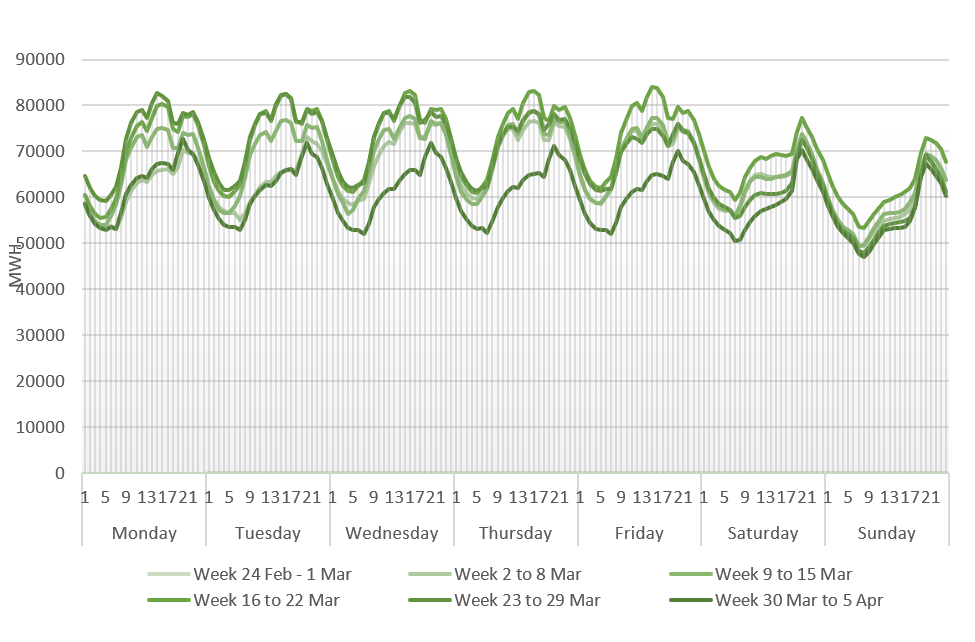
Source: IDB using data from the ONS (2020)
Chile
Chile confirmed its first COVID-19 case on March 3. On April 15, the Chamber of Deputies approved a measure that forbad cuts or suspensions in public services during the 90-day catastrophe state, which runs until mid-June. The coronavirus pandemic brought the economic recovery to a halt, with economic growth of 2.7% in February. The social distancing measures throughout the country are not homogenous. The mining industry was strongly impacted. The curves in figure 6 show an increasing reduction in electricity consumption. In the third and fourth weeks of March and in the first week of April, the average consumption of electricity fell by3.12%, 4.57% and 9.01%, respectively, compared to the first week of March. However, if compared to 2019, the reduction is compensated by the increase in demand in 2019, which was driven by the recent economic recovery.
Figure 6: Electricity Demand Decrease by Hour in Chile (24 February – 5 April)
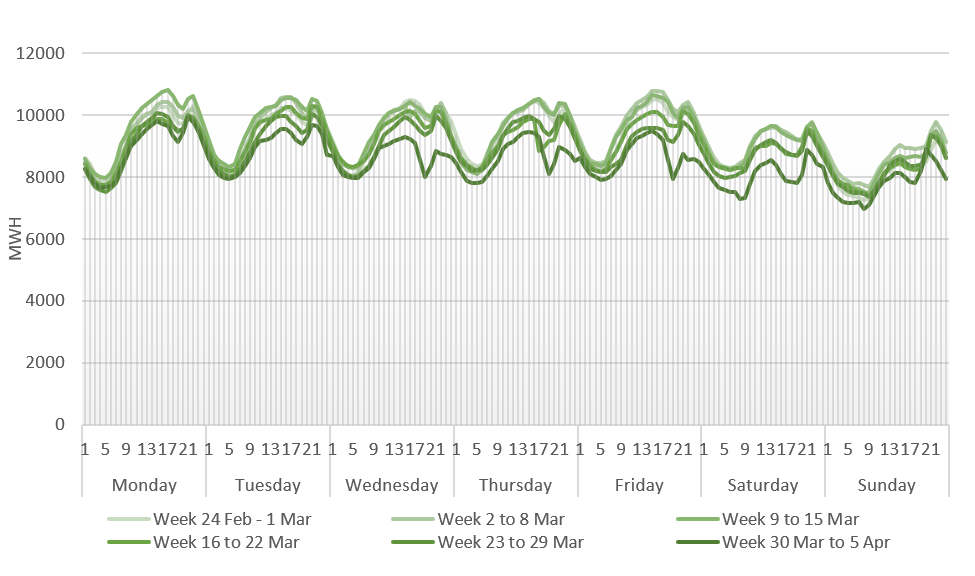
Source: IDB using data from Coordinador Electrico Nacional (2020)
Costa Rica
On March 6, Costa Rica became the first Central American country to confirm a case of COVID-19. Six days later, the government announced the preventive closure of schools. Large meetings were also suspended. On March 16, the government declared a state of national emergency. On April 9 most urban, rural and sub-municipal public transports were suspended and most commercial spaces were closed. Only authorized transport would operate, with 50% of the capacity of essential workers and people going to medical appointments or other emergencies, while stores would sell only essential food and items. Costa Rica’s economy is affected by the reduction of exports, tourism and domestic demand. In comparison to other Latin American countries, the drop in average electricity consumption can be seen as moderate. The reduction in the last two weeks of March and in the first week of April was, of 2.36%, 5.62% and 4.98%, respectively, compared to the first week of the same month.
Figure 7: Electricity Demand Decrease by Hour in Costa Rica (24 February – 5 April)
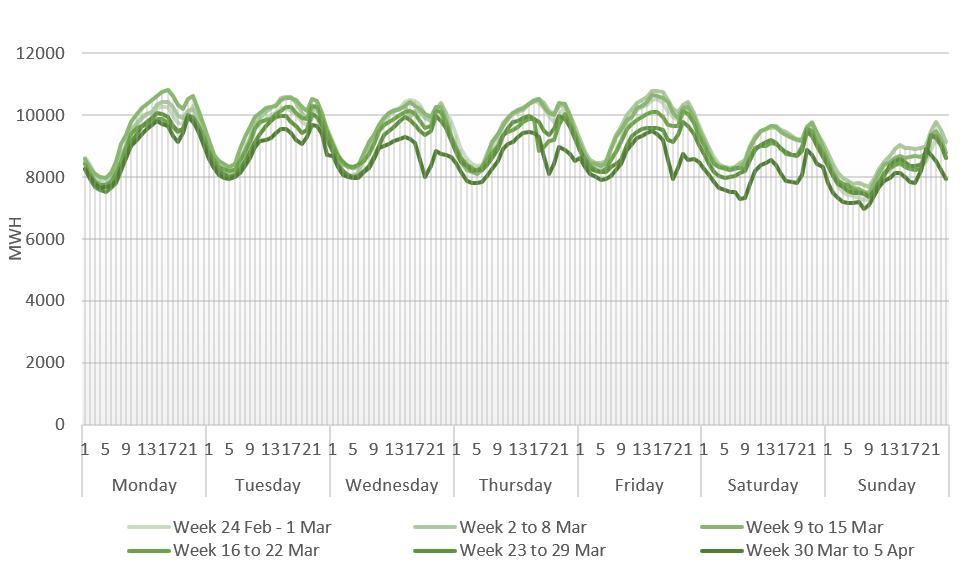
Source: IDB using data from ICE Group (2020)
EL Salvador
El Salvador confirmed the first case of COVID-19 on March 18. The alert status in the country was declared on March 6. Two weeks later, on March 21, a curfew was instated, followed by one month later, on April 6, the total quarantine, as cases slowly rose. The impact on the levels of electricity demand of consumers can be seen soon after the declaration of the curfew. Drops of 16.4% in consumption can be seen in the third week of March, compared to the previous week, and have been consistent since.
Figure 8: Electricity Demand Decrease by Hour in El Salvador (24 February – 5 April)
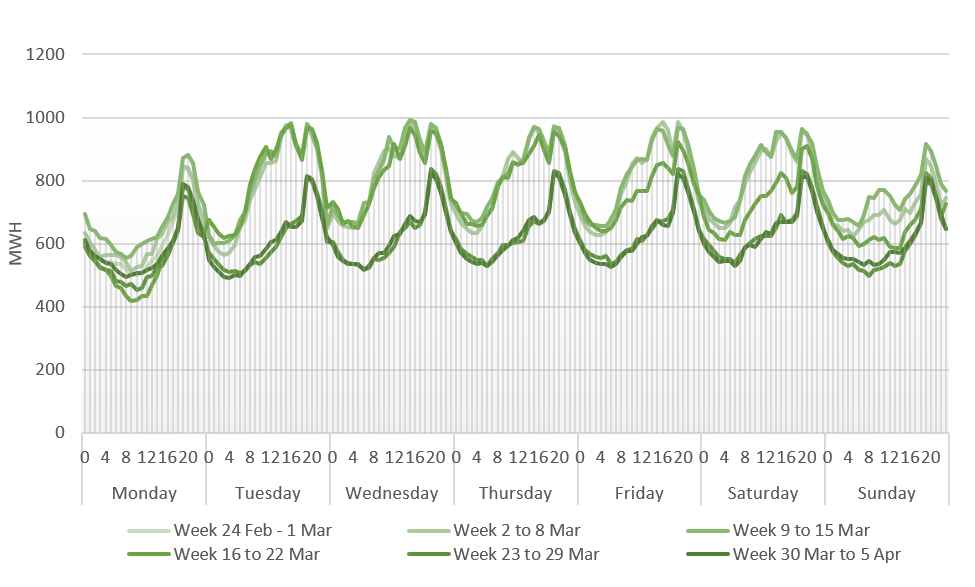
Source: IDB using data from SIEPAC Operator (2020)
Guatemala
Guatemala confirmed its first case of Covid-19 on March 13. Since March 9, the country has remained in a state of emergency. On March 21, the Guatemalan presidency declared a nationwide mandatory curfew and cancelled the celebration of the holy week to prevent the spread of the virus. The social distancing measures led to an observed drop of 6.5% in the electricity demand on the third week of March, which later grew to over 13.7 % the week after, compared to the week before the measures were announced.
Figure 9: Electricity Demand Decrease by Hour in Guatemala (24 February – 5 April)
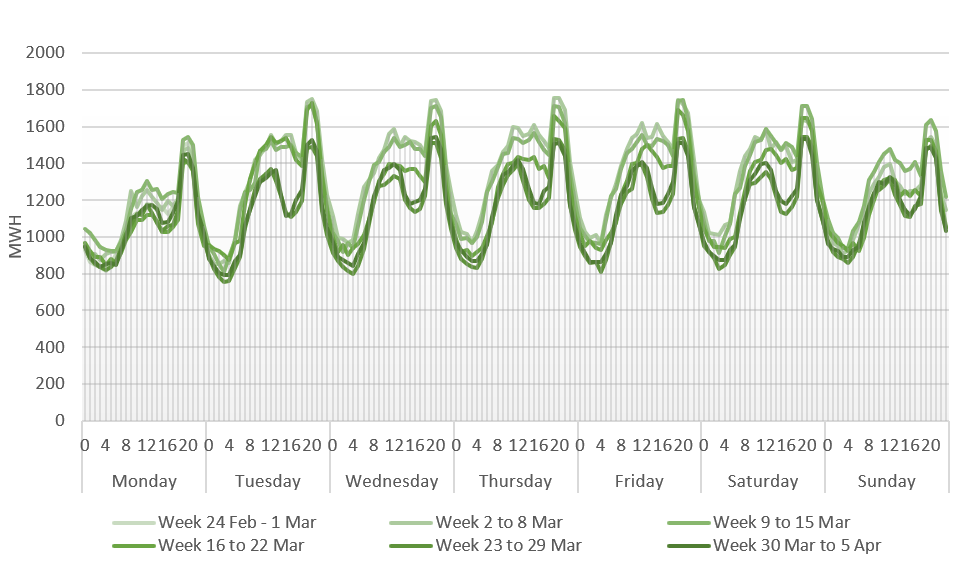
Source: IDB using data from SIEPAC Operator (2020)
Honduras
The government of Honduras declared the national health emergency on March 11, a day after the first case of Covid-19 was detected in the country. On March 13, universities suspended teaching. On March 16, a curfew was decreed for some cities in the country and four days later, on March 20,, the Government announced a countrywide curfew that is still on today. The effect of the curfew compared to the effect of the quarantine in the second week of March is reflected in the electricity demand, as from demand dropped by 9.52% with respect to the week before. It has remained at roughly the same level in the following weeks.
Figure 10: Electricity Demand Decrease by Hour in Honduras (24 February – 5 April)
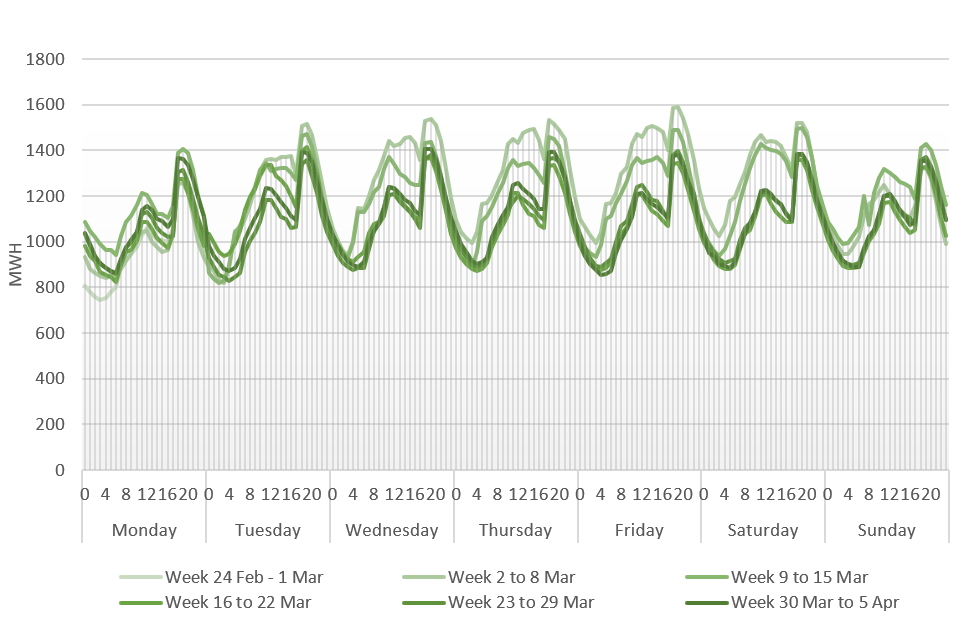
Source: IDB using data from SIEPAC Operator (2020)
Mexico
Mexico confirmed its first COVID 19 case on February 27. On March 30, the government declared a national health emergency. The government announced a series of measures, including the suspension of all non-essential activities, suspension of meeting with more than 50 people, and a strict self-quarantine for people over 60 years old and populations with higher health vulnerability. Schools closed until the end of April. Given the late measures of social withdrawal, electricity consumption continued to grow throughout March. Only in the first week of April does a slight 0.9% drop in electricity consumption occur, compared to the first week in March. Compared to the same period in 2019, there is a decline of 4% of the electricity demand.
Figure 11: Electricity Demand Decrease by Hour in Mexico (24 February – 5 April)
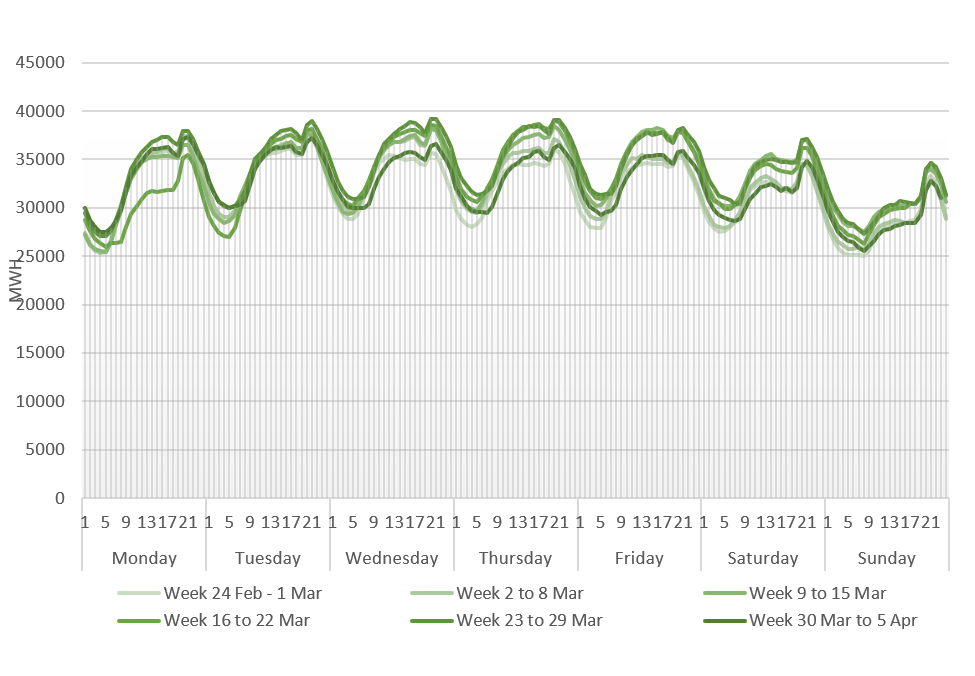
Source: IDB using data from CENACE (2020)
Nicaragua
The Government confirmed the first case of COVID-19 on March 18. Unlike other Latin American countries, the Nicaraguan government has not adopted measures of social withdrawal. In spite of this lack of measures, several local companies, including bars and restaurants, decided to close to protect their employees and customers. As a consequence, reductions in electricity consumption are relatively small and there is no substantial change in the demand profile. The small reductions in the second, third and fourth weeks of March could, therefore, be attributed much more to economic or seasonal issues, rather than to the crisis. During these weeks, there was an average reduction of 0.64%, 1.07% and 2.97%, respectively, on average in energy consumption, compared to the first week of March. This thesis is corroborated by the consumption data for the first week of April, which was the same as for the first week of March.
Figure 12: Electricity Demand Decrease by Hour in Nicaragua (24 February – 5 April)
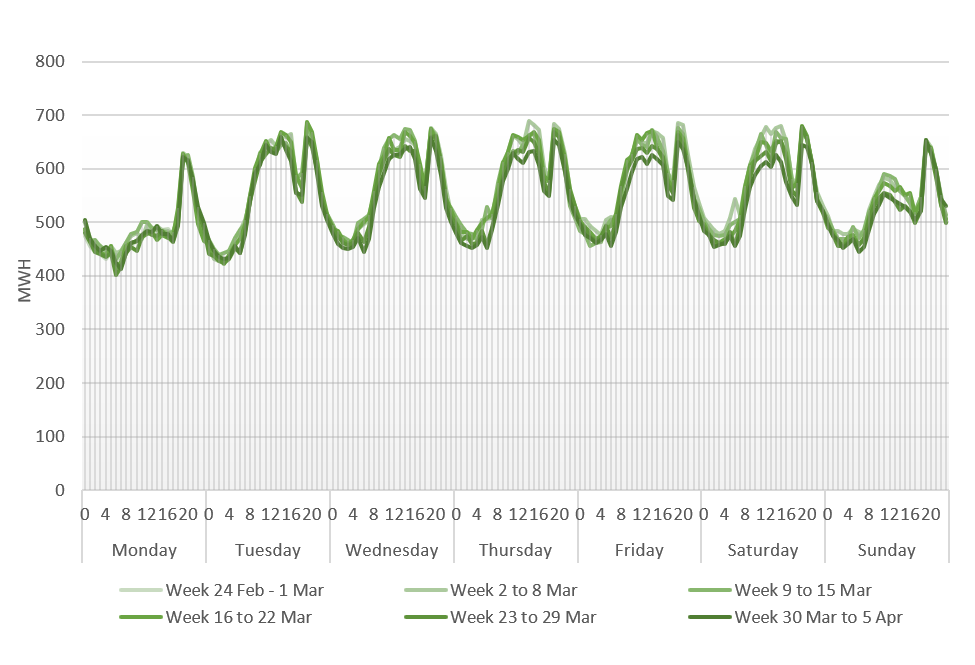
Source: IDB using data from CNDC (2020)
Panama
The Panama Government confirmed the first case of Coved -19 in the country on March 10. Since March 13, the country has remained in a state of emergency and two days later, the state decreed the suspension of class and the discontinuation of some service sector activities. On March 18, a nationwide curfew was decreed for the whole country. The effect of this social distancing measure can clearly be observed. A drop of 9.9% in electricity demand was witnessed in comparison to the levels of the previous week. The drop in demand continued to grow as weeks went by, and as the curfew continued. Electricity demand was reduced by 17.32% in the third week of March, and by 22.02% in the fourth week, compared to the week the curfew was declared.
Figure 13: Electricity Demand Decrease by Hour in Panama (24 February – 5 April)
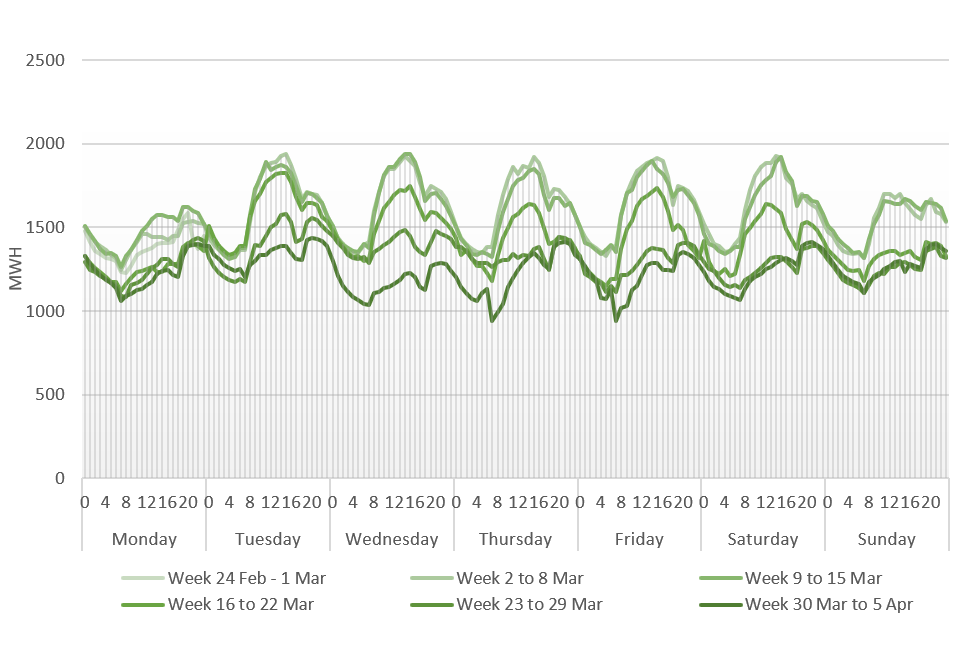
Source: IDB using data from SIEPAC Operator (2020)
Peru
The first case of COVID-19 was announced on March 6. On March 15, the government declared a national state of emergency, with strict controls on the movement of people within the country. The decree requires that all of Peru’s borders be monitored. It also prohibited national travel between the provinces. Peruvians are forced to stay at home, unless they need to buy food or collect medicines. Workers from key sectors, such as health, finance, communication and supermarkets, are however allowed to travel.
The measures adopted had a large effect on economic activity, which is reflected by the abrupt drop in average energy consumption. In the third and fourth weeks of March, and in the first week of April, the average drop in consumption compared to the first week of March was 28.19%, 32.27% and 32.00%, respectively.
Figure 14: Electricity Demand Decrease by Hour in Peru (24 February – 5 April)
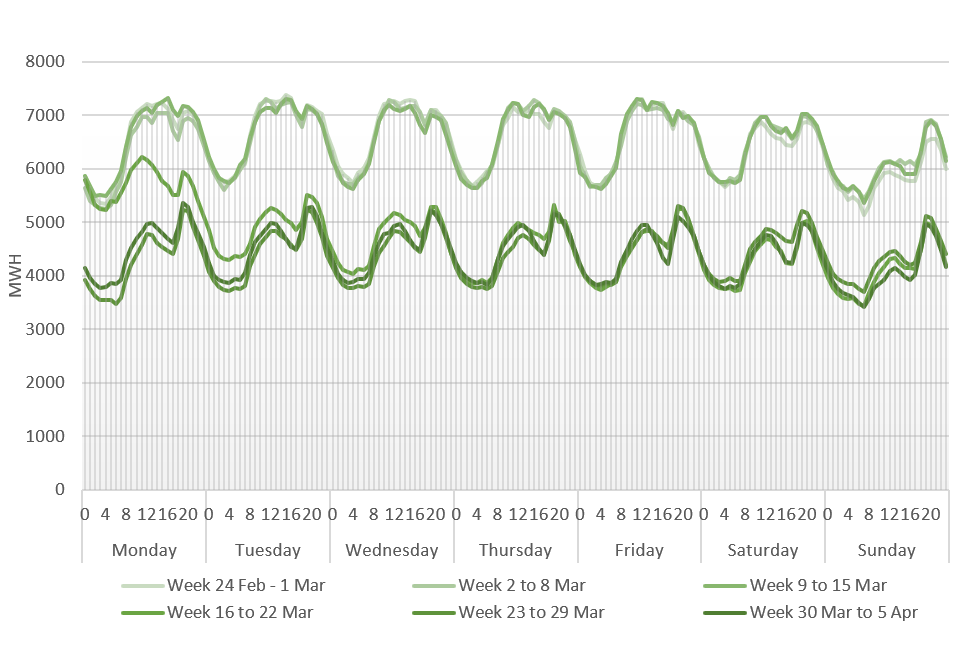
Source: IDB using data from COES (2020)
Uruguay
The first case of COVID-19 was confirmed on March 13. On March 18, the government announced the closure of large retail spaces, such as shopping malls. Uruguay is among the countries where the fight against COVID-19 has significantly affected its economic activity. This is more obvious from the drop in the average electricity consumption in the third and fourth weeks of March, and in the first week of April, of 15.28%, 10.85% and 16.24%, respectively, compared to the first week of March.
Figure 15: Electricity Demand Decrease by Hour in Uruguay (24 February – 5 April)
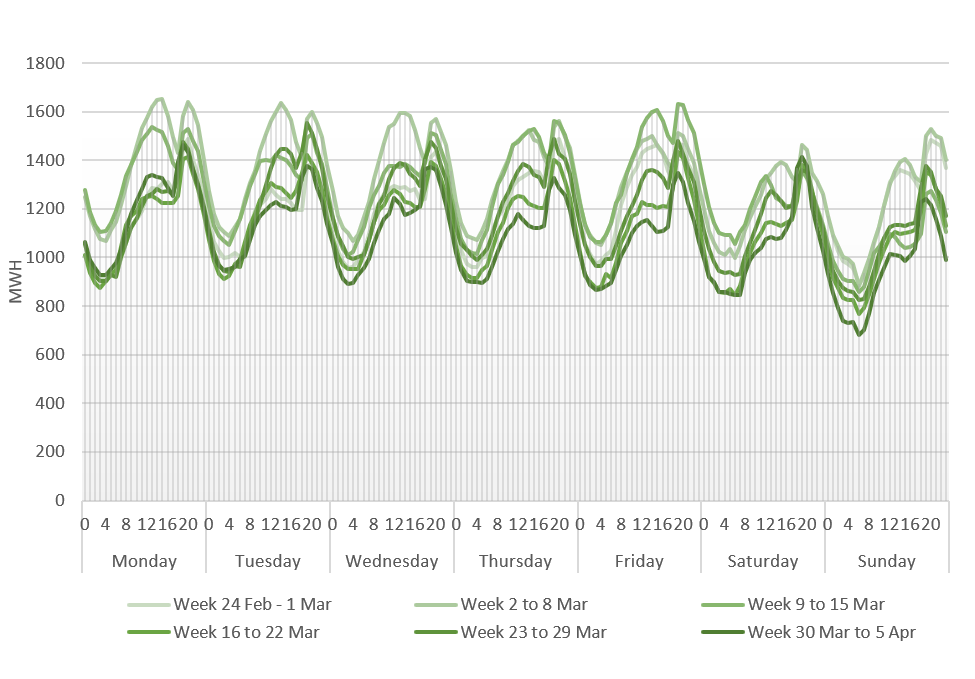
Source: IDB using data from ADME (2020)

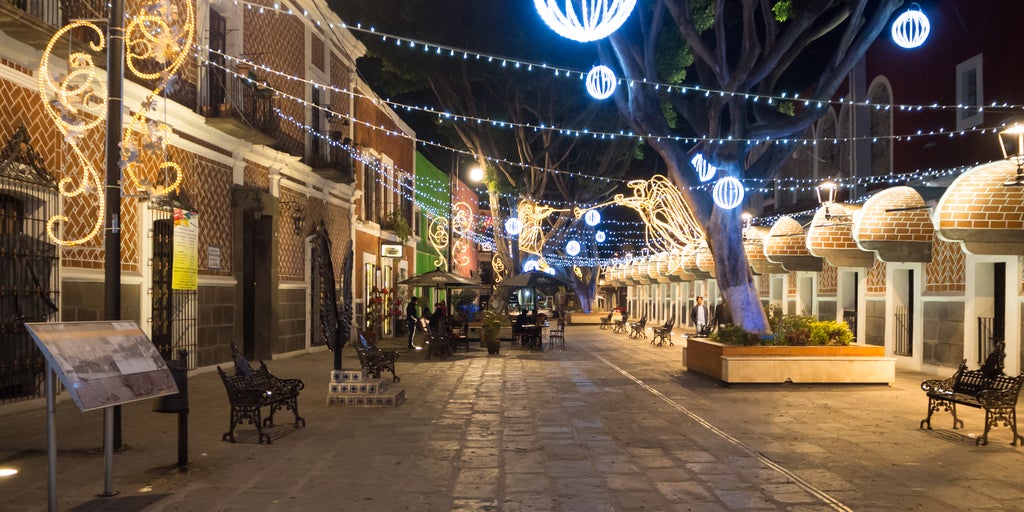
Leave a Reply